How to Get Government Grants for Sustainable Farming Startups in Hungary
Consider this—just over a decade ago, Hungarian agriculture was widely seen as a sleepy old sector, reliant on tradition and unfavorable to outsiders. Fast forward to the present, and everything has changed. Recent EU surveys reveal Hungary enjoys one of the fastest-growing rates of new sustainable agribusiness registrations in Central Europe1. What’s fueling this boom? Well, more than anything, it’s the unprecedented cascade of local and European government grants targeting sustainable farming startups. In fact, according to Hungary’s Ministry of Agriculture, over 420 million euros were allocated to eco-resilient agrifood innovations in the last five years alone2.
Here’s what gets me—when I first started consulting in Central Europe, most aspiring farmers felt government grants were a black box: full of mysterious forms, impenetrable eligibility rules, and, above all, nearly impossible to win. I used to sympathize, since my first attempt to help a friend win an agri-grant ended in a bureaucratic meltdown (more on that later). Yet, over time, I’ve learned: with the right knowledge, persistence, and a sharp eye for detail, the system can become not just navigable but genuinely empowering.
Why Government Grants Matter (and Why You Should Care)
I’ll be completely honest: sustainable agri-startups in Hungary face a daunting financial landscape. Banks are wary, private capital wants quick profit, and crowdfunding? Still in its infancy here. But then you discover government grants—huge, often non-repayable, specifically designed for those with an eye toward eco-friendly innovation, soil health, or rural job creation. According to 2023 data, more than half of all successful sustainable farm launches in Hungary were made possible by some form of governmental or EU program support3.
So, why haven’t more people leapt at the opportunity? Well, most applicants are tripped up by the same handful of obstacles: outdated information, eligibility confusion, and—let’s be honest—a general sense that the Hungarian public administration is set up to slow them down rather than help them succeed. I’ve wrestled with these systems myself and witnessed how nervous applicants often self-sabotage by not reaching out for expert help. That said, the new post-2021 EU CAP (Common Agricultural Policy) has dramatically streamlined some processes, even as others remain, frankly, a headache4.
Understanding Grant Types & Eligibility
This is where things get puzzling: Hungary’s sustainable agriculture funding system is an intricate patchwork of national programs, EU-backed schemes, and regional pilot funds. Some are open only to registered Hungarian companies; others admit EU-wide applicants; still more are exclusive to rural residents. I’ve learned never to assume the rules won’t change mid-cycle (they do, and they will). Currently, the four most common grant types for agri-startups are:
- Direct government grants: Typically managed by Hungary’s Ministry of Agriculture or Rural Development Programme, these focus on crop diversification, water efficiency, eco-innovation, and climate adaptation.
- EU Structural and Investment Funds: Think: European Agricultural Fund for Rural Development (EAFRD), supporting young/female/new entrant farmers in sustainable fields.
- Innovation and pilot funds: For “high-risk, high-impact” agri-tech and regenerative farm experiments (typically consortia—one farm, one researcher, sometimes a local authority partner).
- Regional and city grants: Budapest, Szeged, Debrecen, and other cities occasionally run their own “urban-rural food transition” competitions.
Ever felt uncertain about whether you qualify? You’re not alone. The specific eligibility criteria vary from scheme to scheme, but almost all require:
- Registered business or individual entrepreneur status in Hungary (or in certain pilot grants, within the EU/EFTA/UK).
- Demonstrable experience or credible plan in food, agri, or eco-innovation—though, believe it or not, “experience” can sometimes mean a strong enough business plan rather than formal training.
- Engagement with at least one sustainability axis (carbon reduction, biodiversity enhancement, water/soil management, social innovation—I know, these change routinely).
- Adherence to strict anti-fraud and transparency policies (paperwork warning ahead!)
Hungary is one of only six EU nations where sustainable agriculture grant access is guaranteed by national policy, irrespective of farm size or location—making it uniquely inclusive for rural and urban entrepreneurs alike.
Let that sink in for a moment. Now, before you rush off to start your application, let’s explore which grants are most relevant—and winnable—for your specific project.
Top Sustainable Farming Grants in Hungary (2024 Edition)
Here’s the thing—grant “menus” change with political cycles, new EU frameworks, and (often) with not much public warning. Based on my experience, these are the most accessible and impactful options for new sustainable agri-entrepreneurs right now (as of this summer):
- Young Farmers Start-Up Support (Fiatal Gazda támogatás): The most popular entry point for first-time Hungarian farmers (under 40). Up to €35,000 in non-repayable finance, paid in tranches over 3-5 years, as long as sustainability commitments are met. Last year, three of my mentees won on their first try—a testament to its accessibility with a solid business plan5.
- EAFRD Green Innovation Fund: An EU-driven pot targeting “beyond organic” projects—think vertical farms with closed-loop water, integrated agroforestry, biogas, or AI-driven composting. Funding can exceed €200,000 for consortium pilots but usually requires research/industry partners.
- Hungarian Rural Development Programme (VP Operative): Multiple calls annually for eco-certification, renewable energy deployment, biodiversity corridors, and soil re-carbonization. Typical grants: €20,000–€100,000 per project. Application cycles can be competitive, but rural projects outside Budapest often stand higher chances.
- Climate and Environmental Innovation Fund: A relatively new, Budapest-backed program for food startups addressing climate risk or “urban farming for public benefit”—microgreens, rooftop gardens, low-impact delivery. Smaller pots (~€5,000–€25,000) but very high acceptance rates for genuinely original ideas.
Meanwhile, be aware: certain grants, especially those tied to the EU’s new CAP and Green Deal action plans, have rolling deadlines or change with little warning. Always double-check official sources (I’ll include verified links below!) and ask for written confirmation of opening/closing dates from the issuing office.
| Grant Name | Type | Max Funding | Who Qualifies? |
|---|---|---|---|
| Young Farmers Start-Up Support | National / EU-backed | €35,000 | Startups, Under 40, Hungarian residents |
| EAFRD Green Innovation Fund | EU | €200,000+ | Consortia, Tech/Research-oriented |
| Rural Development Prog. (VP) | National/EU | €20,000–€100,000 | All regions; focus on rural/eco |
| Climate & Env. Innovation Fund | Municipal | €5,000–€25,000 | Food/Agri-tech, urban impact |
What Kind of Projects Actually Win?
Based on my observations, these application “themes” receive the most attention:
- Regenerative farming/transitioning from chemical to organic or low-input systems
- Water-efficient irrigation/closed system hydroponics
- Soil carbon sequestration, direct biodiversity enhancement
- Climate risk mitigation—for instance, drought/heat-smart orchards
- Smart farm management (IoT, remote sensors, digital traceability)
- Circular food systems (waste composting, micro-mobility logistics)
The Step-By-Step Application Process
Anyone else get overwhelmed by application portals? I cannot count the number of times a promising founder has come to me, halfway through, saying, “I’m lost!” Let’s break it down so you know what to expect—warts and all.
- Define your value proposition. (What makes your project both sustainable and innovative?) Don’t bury the lede—the strongest applications put this front and center, ideally quantified (tons of carbon saved, liters of water conserved).
- Check eligibility and deadlines. Always verify details with the issuing body, not just random blogs—requirements shift every few years6.
- Gather your documents. (See table below) At a minimum: business certificate, tax ID, bank statements, and a business plan matching program requirements.
- Register on the application portal. Most national/EU grants use the Magyar Államkincstár system (State Treasury). Watch for bugs—site maintenance sometimes collides with submission deadlines. (Yes, I’ve seen this happen—double-check and screenshot everything!)
- Write your narrative. Detail your farm’s story, expected outputs, risk mitigation, and sustainability case. Be honest—I once lost points for overhyping “future profitability” without groundwork. Stick to the facts, but don’t undersell surprise social benefits.
- Submit and track. Save all confirmations and correspondence. Follow up if you do not receive prompt acceptance of your file—errors are common and, unfortunately, sometimes fatal to your application. (This is where many fail—lack of persistence!)
| Document | Why Needed? | Common Issues |
|---|---|---|
| Business Certificate & Tax ID | Proof of registration & eligibility | Expired paperwork; incorrect fields filled in Hungarian |
| Bank Statements | Shows financial activity | Incomplete coverage; not accepted if “not certified” by bank |
| Detailed Business Plan | Evaluates innovation, sustainability, profitability track | Non-alignment with program priorities (e.g., not enough biodiversity focus) |
Okay, let’s step back—if this feels like a mountain of paperwork, you’re not wrong. But with a little structure (and maybe an expert peer review), most founders end up learning as much about themselves as about bureaucracy.

Insider Tips & Troubleshooting (from Someone Who’s Been There)
I want to get real for a moment. After helping more than a dozen Hungarian agri-startups navigate the government grant maze, here’s what I’ve learned—the hard way. Almost every application falters on the same couple of hurdles: mismatched paperwork, weak project quantification, and lack of follow-up. Let me clarify that: sometimes, even “winning” applications lose out because the post-approval requirements trip people up.
- Start early. Most people underestimate grant timelines by weeks or even months—the successful are those who build “buffer” time for revising, translating, and chasing missing signatures.
- Align with “flavor-of-the-year” priorities. Each year, funding committees push specific eco-innovation themes (think digitization, water-smart systems, biodiversity resilience). A past mistake: advocating a solar-powered irrigation system in a year when soil carbon was the hot topic. Lesson learned.
- Seek advice—formally and informally. Apply for at least one consultation (most program offices offer these) and ask local agri-cooperatives what’s worked for them. Generally speaking, peers won’t give away all their tricks, but you’ll almost always uncover one essential “unwritten” rule.
- Never fudge the numbers— auditors check every euro! I’ve seen good people get their funding revoked over discrepancies that seemed minor at the time.
- Document everything and save backups in Hungarian and English. Sometimes, an English-language summary convinces a busy reviewer to take a closer look. I’ve helped three projects escape rejection this way.
How Long Does It Take? (And When Will You Actually Get Money?)
Here’s what surprised me most as a newcomer: approvals may take weeks, but actual payments can be months in arrears, especially with EU-driven funds which typically pay out in “tranches.” I recall one grass-fed dairy startup in western Hungary who waited nine months post-approval for their first payment. It was stressful—for everyone, including their community partners and vendors. Lesson? Build a cash cushion and negotiate extended payment terms with suppliers.
Hungary is part of the EU’s “Simplified Cost Options” pilot. This means—sometimes unexpectedly—your grant may be paid as a lump sum if your project shows a clear, measurable impact, eliminating loads of micro-reporting. This was confirmed in both 2023 and 2024 calls by the national Rural Development Office.
What If You’re Rejected? (And Why You Shouldn’t Give Up)
Rejection happens—a lot. On my first grant consulting project, we missed the win simply because our “additionality” argument (the measurable change created by the grant) wasn’t quantified in euros saved per hectare. Did that stop us? Not for long. Most grant calls allow for an appeal or reapplication in the next cycle. More importantly: use the feedback. Some of my best projects only won on their second or third try, having refined their environmental benefits or tightened up their social inclusion metrics.
The Future of Grants & Sustainable Farming in Hungary
Let me think about this. Currently, post-pandemic priorities and energy security are reshaping everything: more climate-smart agriculture, bigger incentives for biodiversity, and, increasingly, digital solutions that monitor or reduce resource use. Many Hungarian farmers I speak with—especially younger ones—are blending tradition and technology in ways unimaginable five years ago. So, what’s coming soon?
- Major expansion of carbon farming initiatives, including direct soil carbon payments (pilot tested in 2024, Hungarian rollout scheduled for 2025)
- Increased competitiveness of integrating agri-tourism and education—projects that directly engage the public now win extra points
- More direct “digital transition” grants for new tech—especially if you partner with universities/IT startups
Putting It All Together: Your Sustainable Startup Roadmap
By now, you’ve probably noticed this is as much about mindset as paperwork. Government grants for sustainable farming in Hungary are not “free money”—they are a partnership, a shared investment in the country’s ecological, economic, and social future. In my own experience, founders who treat it that way—seeing themselves as collaborators, not just applicants—navigate the process more smoothly and unlock bigger long-term value.
- Do your homework. Platforms like the Hungarian Agricultural Chamber and new EU CAP portal are goldmines of current rules, webinar recordings, and example business plans.
- Connect early and often with others already active in the ecosystem. Professional networks, local farmer groups, accelerator programs, and even “informal” mentors make an enormous difference.
- Think long-term. Winning a grant is only step one. Build in regular progress tracking, anticipate audit requests, and plan for sustainability beyond the initial funding period.
Quick Q&A (People Also Ask)
- Is it possible to apply for more than one grant? Yes, but beware of “double dipping”—many programs explicitly forbid overlapping funding for the same costs. Carefully coordinate your applications and disclose all funding sources8.
- Do I need to speak Hungarian? For most government and EU-funded grants, yes—at least enough to fill out application forms and communicate with the local office. Some forms (particularly EU pilot grants) are available in English, but support is generally stronger in Hungarian.
- Can I use grant money for equipment, land, labor, or R&D? Yes, but each grant tightly details what you can claim (and when). Double-check the “eligible costs” table; mistakes here are the #1 reason for clawback demands.
- What if my project is mostly tech/digital? Increasingly encouraged—just make sure there’s a clear environmental or social impact, not just a new gadget for gadget’s sake.
References
In Closing: My Honest Perspective
I’ll close with this: every grant application is a story. Sometimes, you’ll trip over technicalities, even after all this research. Other times, it all comes together in a late-night writing burst or a last-minute consultation with a farmer who’s walked this path before you. The true winning trait? Perseverance, honest curiosity, and the humility to ask for help. Actually, let me add: real change in sustainable farming always comes from those willing to learn from both setbacks and small, surprising victories.
If you’re even slightly considering a foray into Hungarian sustainable farming with grant support—take the leap. The system is more accessible (and more worth it) than ever. Good luck, and may your crops (and your paperwork) flourish!



